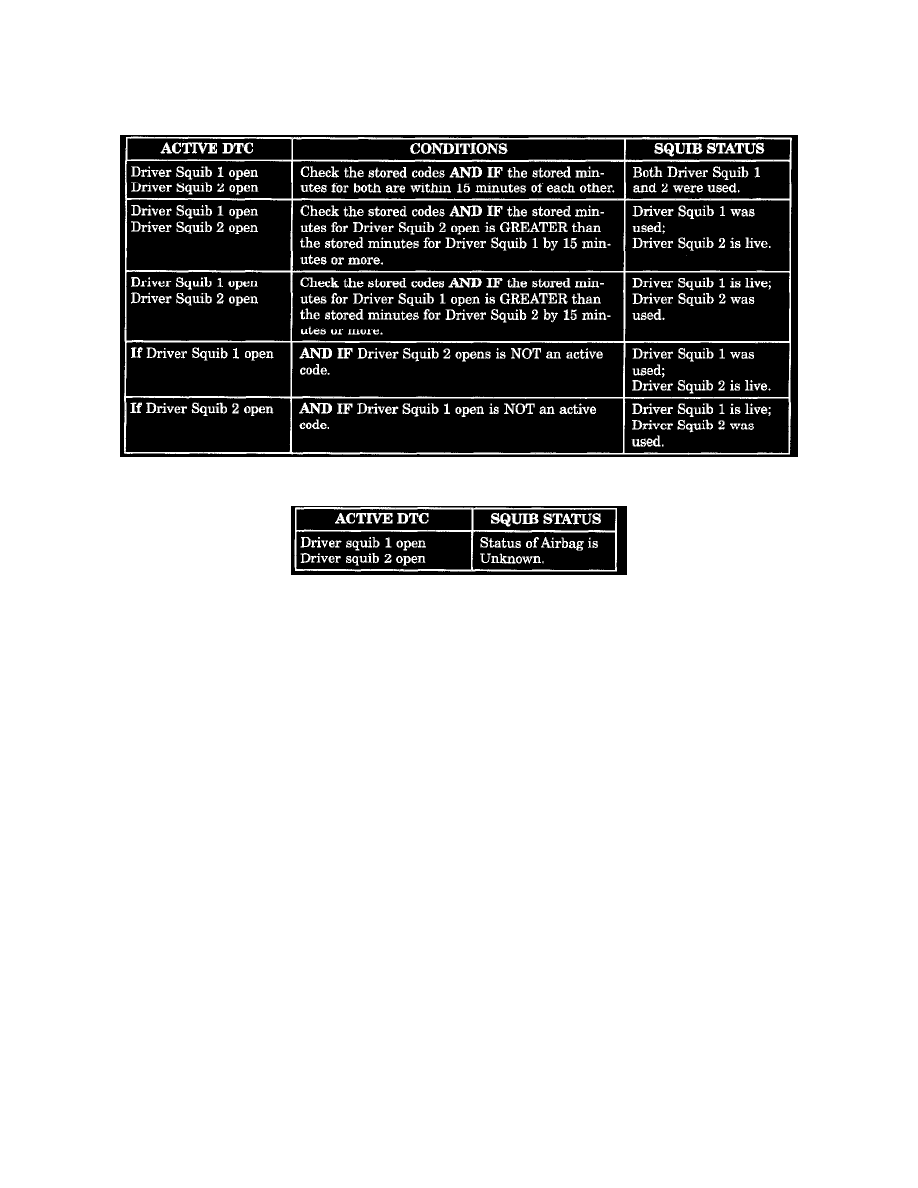Stratus Sedan V6-2.7L VIN R (2002)

and passenger airbags unless you are sure of complete deployment. Please refer to the hazardous substance control system for proper disposal. Dispose
of deployed airbags in a manner consistent with state, provincial, local, and federal regulations. Use the table to identify the status of the airbag squib.
AIRBAG SQUIB STATUS
1. Using a DRBIII(R) read Airbag DTC's.
If the active codes are present.
If neither of the following codes is an active code.
CLOCKSPRING
The clockspring is mounted on the steering column behind the steering wheel. This assembly consist of a plastic housing which contains a flat,
ribbon-like, electrically conductive tape that winds and unwinds with the steering wheel rotation. The clockspring is used to maintain a continuous
electrical circuit between the instrument panel wiring the driver airbag, the horn, and the vehicle speed control switches if equipped. The clockspring
must be properly centered when it is reinstalled on the steering column following any service procedure, or if could be damaged. The clockspring cannot
be repaired and it must be replaced.
PASSENGER AIRBAG
The airbag door in the instrument panel top cover above the glove box is the most visible part of the passenger side airbag system. The airbag door has a
living hinge at the top, which is secured to the instrument panel top cover. Located under the airbag door is the airbag cushion and it's supporting
components. The airbag module includes a housing to which the cushion and hybrid inflators are attached and sealed. For 2002 the front passenger
airbag is equipped with dual stage squib inflators that include a small canister of highly compressed argon gas. The ACM uses vehicle crash severity, to
determine the level of airbag deployment. When supplied with the proper electrical signal, the hybrid inflator or inflators discharge the compressed gas if
contains directly into the airbag. The airbag module cannot be repaired, and must be replaced if deployed or in any way damaged.
WARNING: THE PASSENGER AIRBAG MODULE CONTAINS ARGON GAS PRESSURIZED TO 17236.89 KPA (2500 PSI). DO NOT
ATTEMPT TO DISMANTLE AN AIRBAG MODULE OR TAMPER WITH ITS INFLATOR. DO NOT PUNCTURE, INCINERATE, OR
BRING INTO CONTACT WITH ELECTRICITY. DO NOT STORE AT TEMPERATURE EXCEEDING 93° C(200° F). REPLACE AIRBAG
SYSTEM COMPONENTS ONLY WITH PARTS SPECIFIED IN THE MOPAR PARTS CATALOG. SUBSTITUTE PARTS MAY APPEAR
INTER-CHANGEABLE, BUT INTERNAL DIFFERENCES MAY RESULT IN INFERIOR OCCUPANT PROTECTION. THE FASTENERS,
SCREWS, AND BOLTS ORIGINALLY USED FOR THE AIRBAG SYSTEM COMPONENTS HAVE SPECIAL COATINGS AND ARE
SPECIFICALLY DESIGNED FOR THE AIRBAG SYSTEM. THEY MUST NEVER BE REPLACED WITH ANY SUBSTITUTES. ANY
TIME A NEW FASTENER IS NEEDED, REPLACE IT WITH THE CORRECT FASTENERS PROVIDED IN THE SERVICE PACKAGE
OR SPECIFIED IN THE MOPAR PARTS CATALOG.
CAUTION: Deployed front airbags may or may not have live pyrotechnic material within the airbag inflator. Do not dispose of 2002 model year driver
and passenger airbags unless you are sure of complete deployment. Please refer to the hazardous substance control system for proper disposal. Dispose
of deployed airbags in a manner consistent with state, provincial, local, and federal regulations. Use the following table to identify the status of the airbag
squib.
